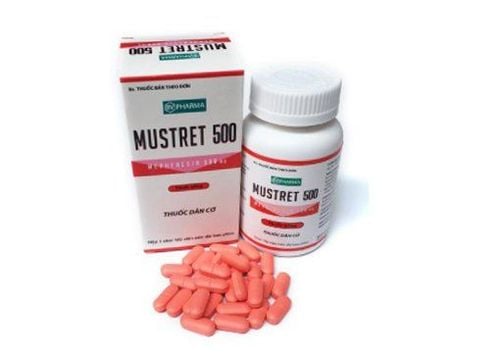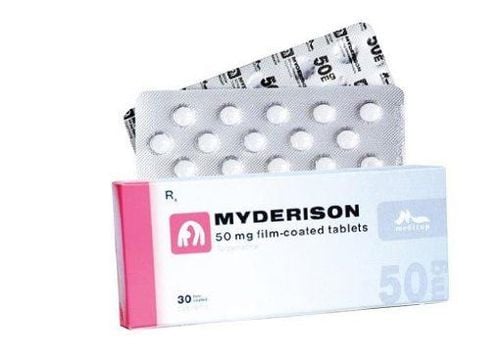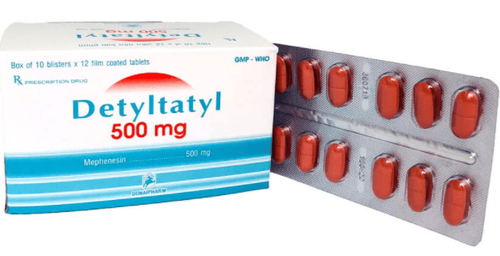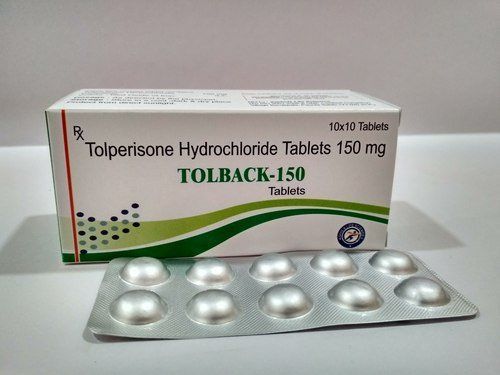This is an automatically translated article.
Synadine 4mg is a drug that acts on the central nervous system, relaxing skeletal muscles. Therefore, this drug is often prescribed by doctors to treat and control symptoms of acute hypertonia, rhabdomyolysis, spinal cord injury causing muscle contraction.1. What is Synadine?
Synadine 4 mg has the main active ingredient is Tizanidin, the drug is usually made in the form of tablets with a concentration of 4mg. Tizanidine is an alpha2-adrenergic agonist, which relaxes skeletal muscle, acts on the central nervous system in the spinal cord and on the spinal cord. Tizanidine inhibits the postsynaptic mechanism in response to muscle tension, primarily by reducing the release of amino acids from interneurons. Tizanidine does not affect neurotransmission. Tizanidin acts mainly on neurons with many synapses, thereby reducing the excitability of motor neurons in the spinal cord, so it reduces muscle contraction and does not weaken the muscle excessively. Tizanidine is well tolerated and is effective against acute and chronic painful muscle spasms of spinal and cerebral origin.2. Indications and contraindications for taking Synadine 4mg
2.1. Indications of Synadine 4mg
Synadine is a short acting drug in the control of acute hypertonia. In addition, the drug is also effective in treating symptoms of muscle spasms, tremors, and pain caused by muscle contractions. Synadine is indicated for patients with spasticity due to spinal cord injury. 2.2. Contraindications to the drug Synadine 4mg
Patients who are allergic or sensitive to Tizanidin or any component of Synadine. Children under 16 years of age: There is not much experience in the safe use of this drug in this age group. Patient is taking Ciprofloxacin or Fluvoxamine.
3. How to take Synadine 4mg
The drug is to be taken orally, during or away from a meal and should not be changed. If you switch from taking the drug with a meal to a meal, it may change the time of onset of action and the appearance of unwanted side effects. Adjust the dose of Synadine according to the patient's condition and response.
The drug should not be used in children because the safety of the drug has not been established with this group.
3.1. Synadine drug dosage
Treatment of muscle spasticity caused by neurological disorders
Synadine dosage is adjusted depending on the disease condition. The usual starting dose is 2mg/time x 3 times/day. The dose can be increased gradually 2-4mg each time, spaced at least 3-4 days or 1 time a week / 1 increase. The dose of Synadine should not exceed 36mg/day.
Treatment of pain caused by muscle contraction
Dose 2-4mg/time x 3 times/day. In severe cases, an additional dose of 2-4 mg can be taken at night. The hypotonic effect is usually maximal 1-2 hours after the first dose and disappears after 3-6 hours. Therefore, in order to avoid drug intolerance, it is necessary to determine the maximum dose and duration of the drug for each patient.
3.2. Synadine overdose and management
Overdose of Synadine can cause hypotension, bradycardia, dizziness, pupillary constriction, coma, and especially patients with respiratory depression.
Use general poisoning treatment methods to help eliminate drugs such as gastric lavage, using activated charcoal, diuretics such as Mannitol, Furosemide. In addition, treat symptoms and use supportive treatment measures.
Monitor the patient for vital signs, respiration, central nervous system function, continuous ECG and heart monitoring, water and electrolyte balance.
4. Use caution
Synadine may cause bradycardia by prolonging the QT interval. Tizanidine may cause hypotension, which is dose-dependent and occurs after a single dose of ≥ 2 mg. Synadine should be used with caution in patients with cardiovascular disease, at risk of severe hypotension. Minimize the risk by careful dose titration and monitoring for hypotension before adjusting the dose. Tizanidine has the potential to cause hypotension, warning patients of the potential risk of orthostatic hypotension with its use. Patients with hepatic impairment: Tizanidine may cause liver damage. Serum aminotransferases should be monitored during the first 6 months of dosing (at 1, 3, and 6 months) and periodically depending on clinical status. Where necessary, start with the lowest possible dose and monitor closely for adverse effects. Patients with Renal Impairment: Caution should be exercised in patients with creatinine clearance <25ml/min; dose reduction is required in these patients. If higher doses are used, it is necessary to determine the appropriate dose and increase the dose interval, closely monitor for adverse effects such as: dry mouth, somnolence, asthenia and dizziness, which may be signs of drug overdose. Women taking oral contraceptives: Use caution when using Synadine because its clearance can be reduced by about 50%. Elderly: Dosage is usually the same as that of young people. However, if renal function is impaired, dose adjustment is required. Tizanidine can cause hallucinations or delusions, which usually occur during the first 6 weeks of treatment. Use with caution in patients with mental disorders. The sedative effect of Synadine may be enhanced by concomitant use of certain drugs such as baclofen, benzodiazepines or substances with CNS depressant effects such as alcohol. Kidneys while driving or operating machinery due to the sedative effect of the drug. Pregnancy: Tizanidine has not been adequately studied in pregnant women. Use the drug when absolutely necessary under the supervision of a doctor. Lactation: Synadine should not be used in nursing mothers because it has not been determined whether the drug is excreted in human milk.
5. Undesirable effects when using Synadine 4mg
Digestive system: Nausea, gastrointestinal disturbances, transient increase in serum transaminases, dry mouth. Cardiovascular system: bradycardia, slight decrease in blood pressure. Central nervous system: somnolence, dizziness, asthenia. Less common: somnolence, fatigue, depression, anxiety, paranoia, hallucinations, agitation, speech disturbances. Muscles, bones: myasthenia gravis, dyskinesia, back pain, paresthesia, arthritis Skin: rash, skin ulcers, itching, dry skin, acne, alopecia, urticaria. In order to minimize the undesirable effects of the drug such as drowsiness, fatigue, dizziness, dry mouth, nausea, digestive disorders and hypotension, it is necessary to start with a low dose and then increase it. gradually to an effective dose that the patient can tolerate. It is rare to have to stop taking the drug due to the side effects of Tizanidine.
Before increasing the dose of Synadine, blood pressure should be assessed to avoid the risk of hypotension. Avoid sudden changes in position from lying or sitting to an upright position.
6. Drug interactions
Tizanidine and its major metabolites do not affect the metabolism of other drugs but are metabolised via the cytochrome P450 isoenzyme system. Tizanidin serum concentrations increase when co-administered with CYP1A2 inhibitors including Acyclovir, antiarrhythmics, Cimetidine, Famotidine, Fluvoxamine, Fluoroquinolone... Other hypotensive agents should not be used concomitantly with alpha2-adrenergic agonists. Acetaminophen: Tizanidine slows down the time to maximum concentration of Acetaminophen. Alcohol and other CNS depressants: Alcohol increases peak concentrations by about 15% thereby increasing the undesirable effects of Tizanidine. Co-administration of Synadine with alcohol or other central nervous system depressants (Baclofen, Dantrolen, Diazepam) synergistically inhibits the central nervous system. Oral contraceptives: Tizanidine clearance was reduced by approximately 50% compared with women not taking oral contraceptives. Thus increasing the unwanted effects of Tizanidine. Phenytoin: Tizanidin increases serum phenytoin levels, monitor Phenyltoin drug levels to adjust the dose if necessary. Synadine 4mg is a drug that acts on the central nervous system, relaxing skeletal muscles. Therefore, this drug is often prescribed by doctors to treat and control symptoms of acute hypertonia, rhabdomyolysis, spinal cord injury causing muscle contraction. To ensure effective treatment and avoid unwanted side effects, patients need to take the drug exactly as directed by the doctor.Follow Vinmec International General Hospital website to get more health, nutrition and beauty information to protect the health of yourself and your loved ones in your family.
Please dial HOTLINE for more information or register for an appointment HERE. Download MyVinmec app to make appointments faster and to manage your bookings easily.













